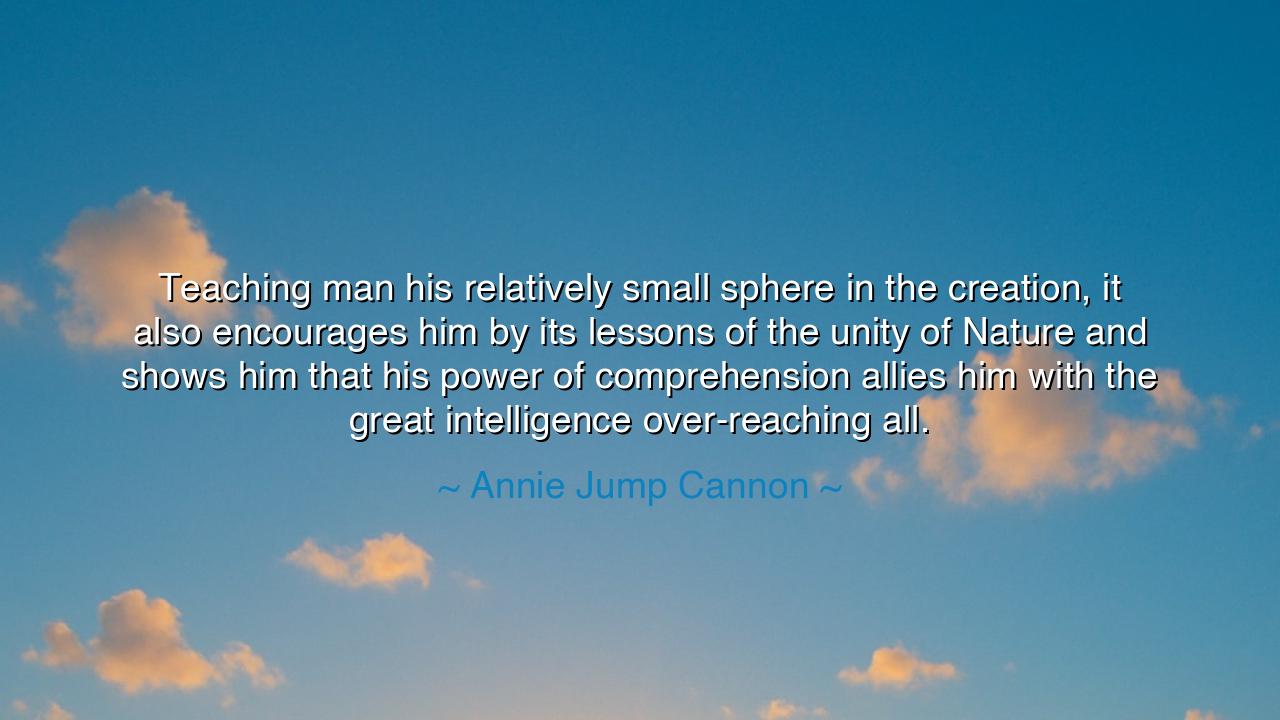
Teaching man his relatively small sphere in the creation, it also
Teaching man his relatively small sphere in the creation, it also encourages him by its lessons of the unity of Nature and shows him that his power of comprehension allies him with the great intelligence over-reaching all.






The Stars and the Humility of Understanding
There are few voices in the history of science that speak with both wonder and reverence as Annie Jump Cannon, the great astronomer and classifier of the stars. In her wisdom, she declared: “Teaching man his relatively small sphere in the creation, it also encourages him by its lessons of the unity of Nature and shows him that his power of comprehension allies him with the great intelligence over-reaching all.” These words, luminous as the constellations she studied, remind us that to know the universe is to be both humbled and exalted—to see one’s smallness in the vastness of creation, yet to recognize that within that smallness lies a spark of the infinite.
The origin of this quote flows from Cannon’s lifelong devotion to the study of the heavens. Born in 1863, she lived in an age when women were often denied a place among scholars. Yet she rose to greatness through perseverance, intellect, and a sense of sacred wonder. Working at the Harvard College Observatory, she developed the system by which stars were classified—a language of light that revealed the nature of suns across the cosmos. Night after night, she gazed into the abyss of space, and what she found there was not loneliness, but harmony. In the silent music of the stars, she heard a truth older than all religions: that the universe is one, bound by order and beauty, and that humanity, though small, is woven into its divine design.
When Cannon speaks of “man’s small sphere,” she reminds us of the humility that must walk hand in hand with knowledge. The ancients once believed that Earth stood at the center of all things, the unmoving throne of creation. But through the courage of seekers—from Copernicus to Galileo—we learned that our world is but one grain among billions, spinning through endless darkness. Yet even as this knowledge shrank our physical stature, it enlarged our spirit. For to understand our smallness is not to despair—it is to awaken to the immensity of existence and to our part within it.
At the same time, Cannon’s words carry a message of encouragement, not diminishment. Though we are small, she says, we are also allied with the great intelligence that shaped the cosmos. The very fact that the human mind can comprehend the patterns of stars, the laws of motion, the chemistry of light—this is proof that we are not strangers in this vast universe, but participants in its order. The unity of Nature is not a distant ideal; it is a living truth revealed in every heartbeat, every breath, every orbit of a planet. To study the universe is to recognize that the same atoms that dance in the stars also form our blood and bones. We are made of stardust—thinking dust, dreaming dust, capable of reflecting on its own origins.
This harmony between humility and grandeur finds echo in the story of Isaac Newton, who, after uncovering the laws that govern the heavens, wrote with awe, “I seem to have been only like a boy playing on the seashore, while the great ocean of truth lay all undiscovered before me.” Here, as in Cannon’s thought, the pursuit of knowledge is not conquest but communion. The scientist and the poet, the believer and the skeptic—all are drawn to the same truth: that to understand is to worship, and to learn is to touch the eternal.
Annie Jump Cannon’s insight bridges the seen and the unseen. By calling the universe our teacher, she places science within the sacred order of learning. It is not cold calculation but reverent exploration—the seeking of divine order in the language of matter and light. She knew that the power of comprehension—the ability to ask, to wonder, to connect—is itself a reflection of the great intelligence that animates all being. Thus, when we study the stars, we are not merely looking outward—we are awakening inward to the consciousness that made us capable of understanding at all.
So let this teaching be written upon the hearts of all who seek truth: be humble before the vastness of creation, but never doubt your belonging within it. Look to the stars not as distant masters, but as kindred lights. Let knowledge be not a tower of pride, but a bridge of reverence connecting your mind to the cosmos. The wise do not seek to dominate nature—they seek to understand it, to live in harmony with its laws, and to reflect its beauty in their own lives.
For the universe does not whisper to those who boast, but to those who listen. As Cannon taught, when we use our intelligence with wonder and our reason with humility, we become partners with the great intelligence that shaped the stars and our souls alike. The heavens are vast, but so too is the human heart when it dares to comprehend. And in that sacred act of knowing, the dust of the earth remembers it was born from light.






AAdministratorAdministrator
Welcome, honored guests. Please leave a comment, we will respond soon